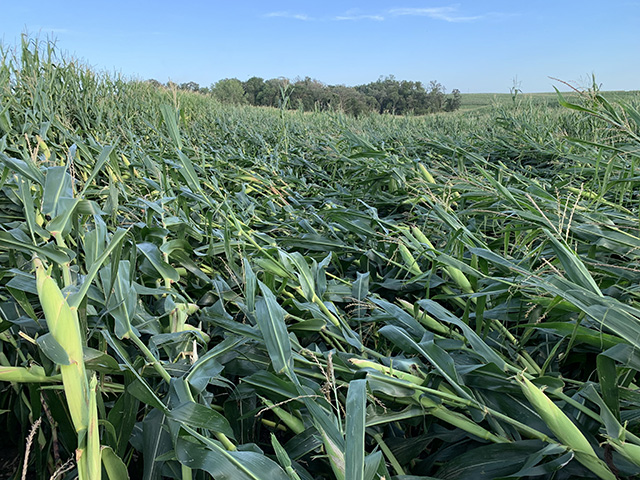
See more information and resources from Iowa State on evaluating your field's yield potential here: https://crops.extension.iastate.edu/….
The other major yield-limiting factor, which has plagued parts of Iowa all summer, is access to moisture. The state's flash drought will reduce any yield estimates, as roots struggle to take in water in damaged fields.
"This is the driest that Iowa has been since the big drought year of 2012," noted DTN Senior Ag Meteorologist Bryce Anderson. "In just over three months -- from early May to mid-August -- Iowa has gone from being drought-free to almost 80% of the state in some phase of drought, with much of the western half of the state in either severe or extreme drought."
WHAT ARE MY HARVEST OPTIONS?
Harvesting damaged fields is going to be a messy, challenging affair. For some severely wind-damaged fields, growers could consider harvesting them for silage, while keeping in mind that this requires specific equipment, storage and end users lined up.
"It's not something you can easily pivot to," Iowa State's Anderson cautioned. Even if farmers can locate the right kind of silage harvesting equipment or custom harvesting crews, storage options can range from silage bags, compressed piles on the ground to different types of silos. "The key is making sure fermentation goes well, and everything is packed tightly at the right moisture, with as little oxygen as possible," she noted.
See this Iowa State article on how to select and prepare a site for silage storage, as well as the different storage options to consider: https://crops.extension.iastate.edu/….
Keep in mind that damaged and drought-stressed fields will not necessarily produce good silage, Iowa State University field agronomist Brian Lang noted in another article. Nitrate concentrations in the stalk could be a problem this year, as could certain mycotoxins from heat-loving fungi like Aspergillus. For more information on harvesting damaged fields for silage, see Lang's article here: https://crops.extension.iastate.edu/….
Growers who wait and proceed with a typical harvest for grain will also face a host of mechanical challenges from the combination of broken, standing and heavily leaning corn plants, Iowa State's Anderson added.
See this guide from Ohio State University on how to harvest lodged corn: https://agcrops.osu.edu/….
HOW DO I STORE THIS?
Grain quality issues in damaged cornfields are very likely this fall, Anderson noted. Growers should watch damaged fields closely and prioritize them for harvest.
Grain storage could also be a problem, as the derecho destroyed many grain storage facilities in its path. See more on that from DTN here: https://www.dtnpf.com/….
For some, harvesting corn early and drying it down could preserve some yield, but they should brace for low test weights, Anderson said.
"There is also a greater potential for ear rots, with so many parts of the plant hanging very close to the ground, without much airflow and with many ears opened up and bruised by hail," she said.
Growers should keep in close contact with their crop insurance adjusters, so issues such as extensive ear or stalk rot can be evaluated in the field before harvest, she added.
For more details on harvesting and storing high-moisture, low-quality or moldy corn, see the North Dakota State University Grain Drying and Storage webpage here: https://www.ag.ndsu.edu/….
WHAT DO I NEED TO KNOW FOR 2021?
To top off the season, farmers with wind-damaged fields will have to consider some nutrient management issues that could emerge. Nutrient concentrations of cornfields differ in earlier growth stages compared to their levels at full maturity, when fields are typically harvested.
"Some fields may not be harvested, some chopped for silage, and some harvested for grain," explained Iowa State ag scientists John Sawyer and Antonio Mallarino, in a recent article. "Nutrients such as nitrogen (N), phosphorus (P), and potassium (K) remaining in the field may be different than with normal harvest due to partial plant removal, grain harvest, or grazing. Therefore, adjustments can be made for future fertilizer or manure applications."
For more on how to calculate your field's nutrient situation and adjust fertilizing plans, see the article here: https://crops.extension.iastate.edu/….
Emily Unglesbee can be reached at Emily.unglesbee@dtn.com
Follow her on Twitter @Emily_Unglesbee
© (c) Copyright 2020 DTN, LLC. All rights reserved.
The Link LonkAugust 20, 2020 at 02:30PM
https://ift.tt/34hS1Ht
Evaluating Wind-Damaged Corn? Check Out These Resources - DTN The Progressive Farmer
https://ift.tt/3gguREe
Corn

No comments:
Post a Comment